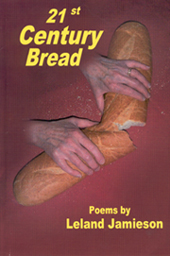|

21st Century Bread
Leland Jamieson
Review by Alyce Wilson
Poet Leland Jamieson prides himself on craftsmanship,
as if evidenced in the very first poem in his collection, 21st Century
Bread,"Needles in a Pinewood," a sonnet that blends the
stanza structure of the Petrarchan sonnet with the rhyme scheme of a
Shakespearean sonnet. He handles the form beautifully, beginning with
an up-close depiction of hiking in a pinewood forest and expanding to
ruminations on the nature of love:
This web of pine roots, pitch-dripped whats and whys,
this marsh of sulphur springs, this mimicry
of love it's said all well-wrought lives construe —
though needling me, quite swing its goad in view.
For his subject matter, Jamieson draws on the personal and the spiritual,
with sections grouped by subject. His final section provides insight
into the poet's craft.
Many of his personal poems are epitaphs, such as "A Landing,"
in memory of "L.S.J.," which seems to commemorate his father,
who was both a writer and pilot before contracting pancreatic cancer.
He chronicles the father's efforts to spend more time with his young
children, despite failing health: reading them stories and taking car
trips.
In other personal poems, Jamieson shares childhood memories of his
family eating berries or spending time in Coconut Grove, Florida. Many
of these poems are dedicated to people who have passed on, listed by
initials alone. At their best, they offer a glimpse into fond remembrances
of people and places.
The fault with these personal poems is that they tend towards sentimentality.
In such moments, Jamieson is prone to exclamation points and superlatives,
as in "Weatherman," which begins, "He shut his eyes —
a happy lad. / Slow warmth suffused his back porch bed. / Boiler men's
lives were not so bad!"
When he turns his pen to those who are not as close to him, he does
so much more deftly, such as in "Blind Spot in the Restaurant,"
which describes a potential romantic association with a humorous ending,
as the man who "gazed obliquely at her dark-lashed eyes,"
longing for a woman across the room, discovers: "But he was umbra
in her optic disk, / invisible — his only warmth was bisque."
The spiritual poems are a bit less accessible, since several of them
are based on Zecharia Sitchin's Earth Chronicles. Jamieson does
provide a lengthy explanation of these books in his notes section, but
even with that information, the poems are less successful. As often
happens when poets try to contemplate such huge topics such as the nature
of religion, the language becomes too self-consciously grand, as in
these lines from "Orthodoxy": "If Inner Eye could see
with full Sixth Sense, / and oft-spooked heart feel safe, what might
they say? / Perhaps they'd say Divine Intelligence / best shows Itself
direct." An entire section of such poems, called "Breaking
21st Century Bread" would probably best have been left out of this
collection.
In the last section, he extols formal verse and explains why he finds
it so inspiring. In "Formal Poet as a Rooster," he writes:
As a violin beneath one's jaw
will resonate in the conch of the ear,
spread gooseflesh through the player's maw,
electrify his chakras' sphere,
impel him toward a right-brained awe —
so may a formal chanticleer.
Furthermore, in his notes on this section, he shares his own methods
of writing poetry, explaining that he allows rhymes to lead him to the
next line's imagery, action or thought. He also states that he has learned
to manipulate meter with enjambment, which leads to a more natural reading.
In conclusion, he provides some tips for poets on writing formal poetry.
Jamieson certainly has spent time perfecting his craft, and many of
the poems in this collection will resonate in the conch of the ear.
Rating: *** (Good)
Lulu.com, 2007:
ISBN 978-1-4303-1734-0
|